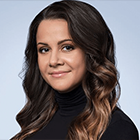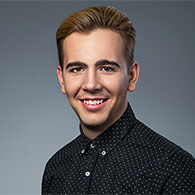11 Best 3D Printers in 2026
Top 11 Best 3D Printers
- Dremel Digilab 3D45 – Our Choice
- FlashForge Creator Pro – Best dual extruder 3D printer
- ELEGOO Mars – Budget 3D printer
- Creality Ender 3 Pro – Best 3D printer for beginners
- Original Prusa i3 MK3S – Best supported 3D printer
- XYZprinting da Vinci Jr Pro – Best compact 3D printer
- LulzBot Mini 2 – Portable 3D printer
- Monoprice Maker Select v2 – Best open-frame 3D printer
- Formlabs Form 3 – Best stereolithography 3D printer
- Ultimaker 2+ – Best Professional 3D Printer
- MakerBot Replicator+ – Best desktop 3D printer
3D printing is the process of recreating a three-dimensional object from a digital file. The print heads – extruders – apply layers of molten filaments on top of each other until the object is completely “printed”. Once you’ve created a 3D model for printing, you can use and modify it as many times as needed. Top large format photo printers with 3D support can use several colors or materials and create large objects or several of them simultaneously.
1. Dremel Digilab 3D45
FixThePhoto editors’ choice
Layer Resolution: 50 – 300 microns | Build Area: 10 × 6 × 6.7 inches | Printable Materials: Nylon, eco-ABS, PLA, PETG | Printing Speed: 150 mm/s
$![]() VIEW IN AMAZON
VIEW IN AMAZON


⊕ Terrific print quality and accuracy
⊕ Multiple connectivity options
⊕ Color touchscreen
⊕ Powerful open software, simple installation
⊕ Quiet, safe design
⊖ None found
Being possibly the best enclosed 3D printer with a HEPA-filter, Dremel 3D45 offers impressive connectivity options and additional features like a monitoring camera and a large touchscreen. Dremel works with its own filaments that automatically adapt to the needed settings.
The direct-drive extruder and heated plate help improve the print quality, the cleanliness of the surface, and minimize the model’s distortions.
Dremel offers a resource library for teachers, including curriculums on 3D-printing. The built-in software allows adjusting 3D models and using the device as a stand-alone printer by connecting an SD card. The community has an open system that allows downloading free models.
- Check out the best photo printer for photographers.
2. FlashForge Creator Pro
Metal frame 3D printer with 2 nozzles
Layer Resolution: 100 – 500 microns | Build Area: 5.8 × 8.9 × 5.9 inches | Printable Materials: PLA, ABS, Elastic, PVA, HIPS, PETG, TPE, TPU, PP | Printing Speed: 10 – 200 mm/s
$![]() VIEW IN AMAZON
VIEW IN AMAZON


⊕ Double extruder and LED light
⊕ Comes with spare parts and a memory card
⊕ LCD screen and SD-card slot
⊕ Closed metal construction
⊖ Layer could have been thinner
⊖ Needs to be constantly adjusted
Thanks to the dual-extruder design, Flashforge Creator Pro is suitable for anyone, who wants to print in several materials or colors simultaneously. The printer has a solid construction with a metal frame and a new assembly platform that supports high temperatures and was redesigned to support stable vertical movements for better print quality.
The use of a double extruder makes FlashForge 3D printer Creator Pro faster and more stable. It can print using ABS, PLA, nylon, soluble filaments, and even composite materials like wood and metal.
- View the best all-in-one photo printers.
3. ELEGOO Mars
Affordable UV-photocuring 3D-printer
Layer Resolution: 10 – 200 microns | Build Area: 4.7 × 2.7 × 6.1 inches | Printable Materials: Rapid Resin | Printing Speed: 22.5mm/h
$![]() VIEW IN AMAZON
VIEW IN AMAZON


⊕ Accurate, high-quality results
⊕ Color touchscreen
⊕ Protective acrylic coating
⊕ Open-source code software
⊖ Only has a USB port on the back
⊖ Limited assembly size
ELEGOO Mars is the best budget 3D printer for those who prefer stereolithography. This resin 3D-printer is a more scalable version of the previous models and is capable of printing multiple parts simultaneously without a loss in speed.
Despite its low price, this model offers accurate printing with the resolution on the X- and Y-axes reaching 47 micron. This means the 3D-prints will be smoother, with better surface processing, fewer bulges, and no visible layers.
- Check out the best photo printing services.
4. Creality Ender 3 Pro
Affordable semi-assembled kit
Layer Resolution: 100 – 400 microns | Build Area: 8.7 × 8.7 × 9.8 inches | Printable Materials: PLA,PETG,ABS | Printing Speed: up to 180 mm/s
$![]() VIEW IN AMAZON
VIEW IN AMAZON


⊕ Affordable and customizable set
⊕ Open software, renewable printing
⊕ Magnetic surface, heating
⊕ Protected from power surges and blockage
⊖ Requires setup and initial configuration
⊖ Open construction
This 3D printer is highly modifiable, especially software-wise, but the initial setup and configuration require your patience for about an hour. Supplied with an improved, magnetized platform with heating, it has a useful function of resuming the printing process from the cancellation point.
If you're planning on spending less than $300 on the 3D printer for terrain, then you can’t expect better print quality. Nonetheless, it’s good enough for beginners, and the open-source code will help 3D printing enthusiast get a kick out of hacking and modifying their printer.
5. Original Prusa i3 MK3S
Quality guaranteed by Prusa Research
Layer Resolution: 50 – 350 microns | Build Area: 9.8 × 8.3 × 8.3 inches | Printable Materials: PLA, ABS, PET, HIPS, Flex PP | Printing Speed: up to 200 mm/s
$ VIEW IN PRUSA


⊕ Exceptional print quality
⊕ Expanded calibration and monitoring
⊕ Great community support
⊕ Powerful open software
⊖ Open construction requires setup
⊖ Few connectivity options
Original Prusa i3 series is one of the most widely-used and cloned 3D-printers available in the form of a set, expert build, or set of improvement plans. Each Prusa printer undergoes detailed diagnostics and factory testing, which is why they’re so reliable and initiate several calibration tests.
Thanks to the use of the latest Trinamic 2130 drivers and the Noctua cooler, this printer offers nearly silent performance. Powerful improvements like bulb sensors, a smart assembly plate, the Bondtech extruder, the PINDA 2 sensor, and E3D V6 nozzle are some of the best on the market and provide unparalleled printing quality.
Pure technical mastery, printing quality and functionality, documentation, and tech support, a large variety of built-in calibration procedures, error detection and repair systems make this smart and universal model the best 3D printer under 1000 dollars.
6. XYZprinting da Vinci Jr Pro
Compact 3D-printing for professionals
Layer Resolution: 20 – 400 microns | Build Area: 5.9 × 5.9 × 5.9 inches | Printable Materials: PLA, Antibacterial PLA, Tough PLA, PETG, Wood | Printing Speed: up to 160 mm/s
$![]() VIEW IN AMAZON
VIEW IN AMAZON


⊕ Good print quality without misprints
⊕ Quiet and easy to use
⊕ Possibility to use third-party software and materials
⊕ Acceptable cost and expenditures
⊖ Poor documentation
⊖ Design makes it difficult to access the object
The fact that this is a budget model doesn’t mean it produces poor results as 3D objects created with this printer are highly impressive considering its price and desktop size.
This simple-to-use 3D-printer works on the “plug-and-work” principle, meaning you can start using it straight out of the box. It uses the most popular types of plastic filaments, which makes it more accessible while maintaining low operational costs.
The completely closed design makes it safe for beginners and enthusiasts as it protects users from high temperatures.
7. LulzBot Mini 2
Portable or desktop universality
Layer Resolution: 50 – 400 microns | Build Area: 6.3 × 6.3 × 7.1 inches | Printable Materials: ABS, PLA, PETG, HIPS, HT, Polyamide, Nylon, Polycarbonate, PC+PBT, PCTPE | Printing Speed: up to 300 mm/s
$![]() VIEW IN AMAZON
VIEW IN AMAZON


⊕ Simple and quiet operation
⊕ Fast printing and variety of materials
⊕ LCD screen and an SD-card slot
⊕ Self-leveling with powerful software
⊖ Open frame construction
⊖ Expensive for 2 connectivity options
LulzBot Mini 2 is a great beginner-friendly choice with decent print speed/accuracy, low noise levels, large printing platform with a flexible Hexagon print head and heating for tons of materials. HIPS is recommended, but you can also use Nylon, ABS, PLA, T-Glase, and even wood or stone, which is great for artists, commercial prototypes, and educational purposes.
Each cycle starts with nozzle cleaning and self-leveling, which secures a clean and even heating base. Software is easily updated and allows picking the level of difficulty/control. There’s a base interface for simple settings and an “Additional” tab for more in-depth control over the various parameters. To complement the printing experience, artists and designers can access a wide variety of pre-made models and assets from any free 3D models websites. Integrating high-quality free 3D models into their projects allows users to enhance their designs, save time, and focus on bringing their creative visions to life with the LulzBot Mini 2.
8. Monoprice Maker Select v2
Printing right out of the box
Layer Resolution: 100 – 400 microns | Build Area: 7.9 × 7.9 × 7.1 inches | Printable Materials: ABS, PLA, XT Copolyester, PET, TPU, TPC, FPE, PVA, HIPS | Printing Speed: 10 – 70 mm/s
$![]() VIEW IN AMAZON
VIEW IN AMAZON


⊕ Extruder works with various materials
⊕ Large assembly area
⊕ Heated platform and sturdy frame
⊕ Comes with PLA and a Micro-SD Card
⊖ Open build
⊖ Settings aren’t very simple
MSP has a spacy assembly format of 8 by 8 inches. This means that you can print large parts or several smaller parts simultaneously to reduce production time. The assembly plate can also heat up, which helps prevent the cooling, compression, and deformation of extruded filaments.
You’re not limited to PLA-filaments as this Monoprice 3D printer can also use ABS, wooden filaments, PVA, and other materials. MP Maker Select is one of the best options if you’re not ready to purchase an assembly kit and put together a printer yourself.
9. Formlabs Form 3
Low force stereolithography resin printer
Layer Resolution: 25 – 300 microns | Build Area: 5.7 × 5.7 × 7.3 inches | Printable Materials: Photopolymer Resin (Tough, Rigid, Durable, Flexible, Elastic, Draft, High Temp) | Printing Speed: variable
$ VIEW IN FORMLABS


⊕ Terrific print quality and precision
⊕ Supports multiple users and molds
⊕ Resin cartridges are automatically filled
⊕ USB, Wi-Fi, Ethernet and touchscreen
⊖ Third-party resin voids the warranty
⊖ SLA-molds require post-processing
FormLabs specializes in low-force, UF resin-based stereolithography. Form 3 is popular thanks to its new optics mechanism and vacuum-packed laser with dust protection. Meanwhile, the flexible forming surface minimizes adhesion problems.
With the well-developed PreForm software, the entire printing preparation can be reduced to a single button press. Sensors provide feedback, and the printing queue controls and web-app are terrific solutions for producing and creating prototypes.
The broad array of materials and technology makes Form 3 one of the most universal printers on the market: simply insert the resin cartridge in the auto-filling resin tray. It’s perfectly suited for 3D printing miniature figurines, creating high-quality prototypes, dental and jewelry items.
10. Ultimaker 2+
Robust desktop 3D-printer
Layer Resolution: 20 – 600 microns | Build Area: 8.8 × 8.8 × 8.1 inches | Printable Materials: PLA, ABS, CPE, Nylon, CPE+, PC, PP, TPU | Printing Speed: 30 – 300 mm/s
$ VIEW IN ULTIMAKER


⊕ Top-notch precision and print quality
⊕ Powerful software and platform heating
⊕ Broad range of materials
⊕ Comes with print heads
⊖ Basic interface and open frame
⊖ USB designed only for firmware
If you’re a designer or a serious 3D-printing enthusiast, then Ultimaker 2 offers incredible print quality and supports a large number of materials. The printing process itself is done securely and quietly, and the accuracy of the 3D-copies is very impressive.
The structure of the assembly camera isn’t hermetically sealed, but the front glass doors don’t let any heat pass through. Loading the filament is easy: the system simply opens a slot, you add the filament and close it. The printer is delivered with a heated base and is automatically calibrated by checking grid points. The model has an extruder system with removable and adjustable print heads.
11. MakerBot Replicator+
Award winning desktop 3D-printer
Layer Resolution: 100 – 400 microns | Build Area: 7.6 × 11.6 × 6.5 inches | Printable Materials: PLA, Tough PLA, Bronzefill, Copperfill, Woodfill | Printing Speed: up to 175 mm/s
$![]() VIEW IN AMAZON
VIEW IN AMAZON


⊕ Simple to control, changeable extruders
⊕ Color LCD screen and 2GB of memory
⊕ Plenty of connectivity options
⊕ Powerful software, and closed, secure construction
⊖ Complicated mobile app setup
⊖ Rather expensive native filament
MakerBot Replicator is the best 3D printer in terms of design as it offers ease-of-use and connectivity, allowing you to use your smartphone, tablet, or PC for all your 3D-printing needs. It has a full-color 3.5” LCD screen with an intuitive control disk and a built-in camera inside for remote monitoring using the MakerBot app available on Android and iOS.
Makerbot Replicator + aims for quality and stability, supplementing them with good assembly volume. It uses the PLA MakerBot filament and is very convenient for the consumer thanks to the precision-factory leveling with automatic Z-homing. Replicater+ is one of the best models for consumer 3D-printing needs and is even approved for usage in educational establishments.
List of the Best 3D Printers
| Image | Name | Features | |
|---|---|---|---|
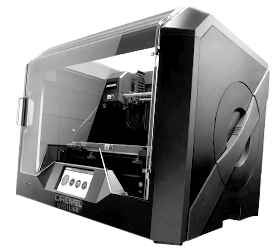 |
Dremel Digilab 3D45
OUR CHOICE |
Check PRICE → | |
 |
FlashForge Creator Pro
DUAL EXTRUDER |
Check PRICE → | |
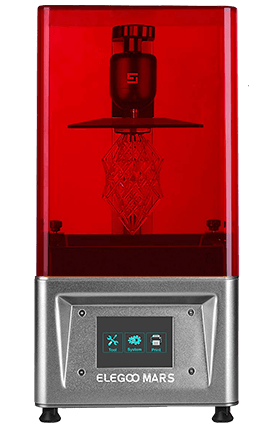 |
ELEGOO Mars
BUDGET |
Check PRICE → | |
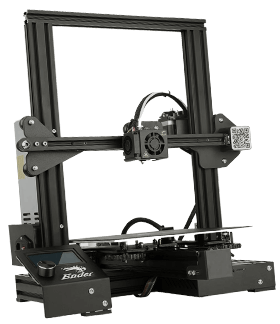 |
Creality Ender 3 Pro
FOR BEGINNERS |
Check PRICE → | |
 |
Ultimaker 2+
PROFESSIONAL |
Check PRICE → |
How to Choose the Best 3D Printer?
If you’re making miniature copies or jewelry items, SLA resin printers will provide laser accuracy. Enthusiasts will need a model that is easy to install and maintain, while professionals will want quality and precision. Enterprises and factories can be serviced by an industrial printer with a large build area for several objects.
3D-Print Basics
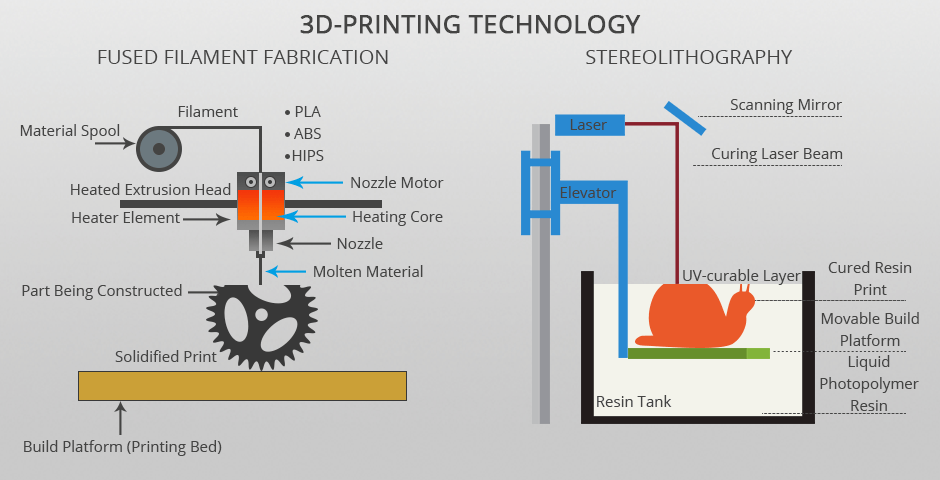
3D-printing technology. FFF (fused filament fabrication) printers work by fusing plastic filaments in a print head and applying them in layers to form a model from the base on its platform. The 3D printer price for such models is lower, FFF are simpler in use, but require more safety measures.
SLA (stereolithography) printers use a focused ultraviolet laser for solidifying photosensitive resin. The difficulties in the production process are caused by inconvenient resin loading, the limited color scheme, creation of degradation products, and the post-processing of solidified items in special solutions.
Materials for printing. A 3D printer filament with a thickness of 1.75 or 3mm is available in 1kg coils: polylactic acid (PLA), acrylonitrile butadiene styrene (ABS), nylon, elastomer (TPE), polystyrene (HDPE, HIPS). Some companies create their signature coils or cartridges for their brand’s printers. Make sure that a filament or coil suits your printer before you buy it.
The best 3D printers can use a broad range of materials: wood, bronze, brass composite filaments, polyether, polyvinyl alcohol (PVA), polyethylene terephthalate (PETT), and polycarbonate. Each material has its own melting point and is limited in the number of compatible printers.
Stereolithographic printers use photosensitive (UV-solidifiable) liquid resin available in a few tones in bottles or cartridges. Finished resin 3D printer miniatures can be either rigid or flexible and elastic. Having to deal with liquid resin and isopropyl alcohol for treating the prints is rather dirty work.
3D-Printing Specifications
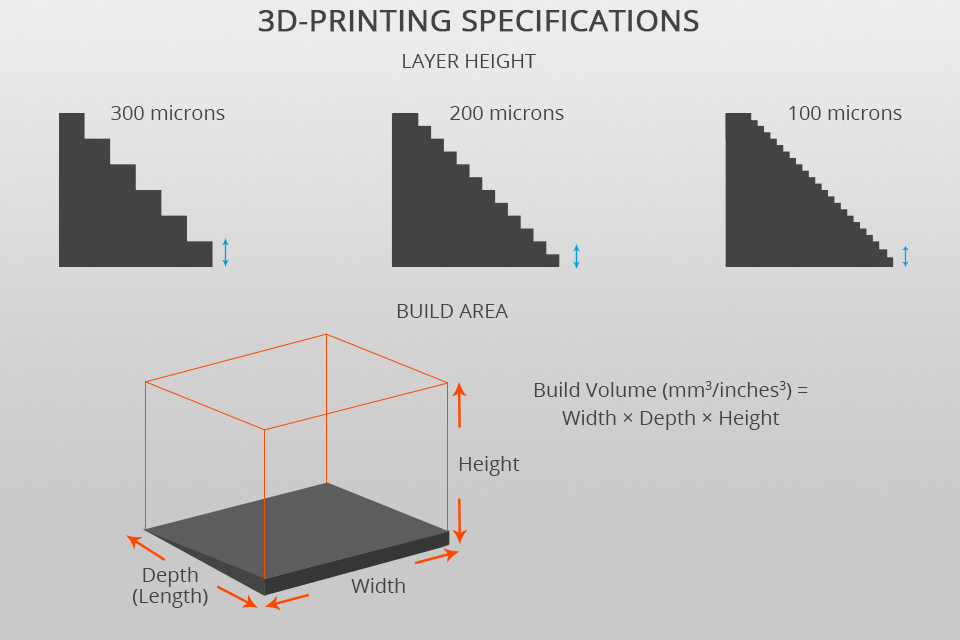
Layer height. The extruder squeezes out consistent layers of melted plastic according to the instructions included in the object’s print file. The resolution is equal to the height of the layer and is measured in microns, which equals 0.001mm. The lower the value, the more highly detailed, accurate, and smooth the final product will be. Some models can print in up to 20 microns, but the higher resolution increases the printing time.
3D-printing speed. The print head movement is measured in mm/sec. You always have to find a compromise between speed and print quality. For printing a 3-4” item, you’re going to need from 6 to 12 hours, depending on the chosen speed from 30 to 300mm/sec. SLA printers are faster than FFF since the print head doesn’t move in layers.
Print volume. The printed item is always limited in maximum size. The build space is determined by the size of the print plate and the vertical distance covered by the print head. It’s measured in inches or centimeters, sometimes cubic ones. Make sure that the build area of your chosen 3D printer is large enough for your future projects.
Advanced Functions
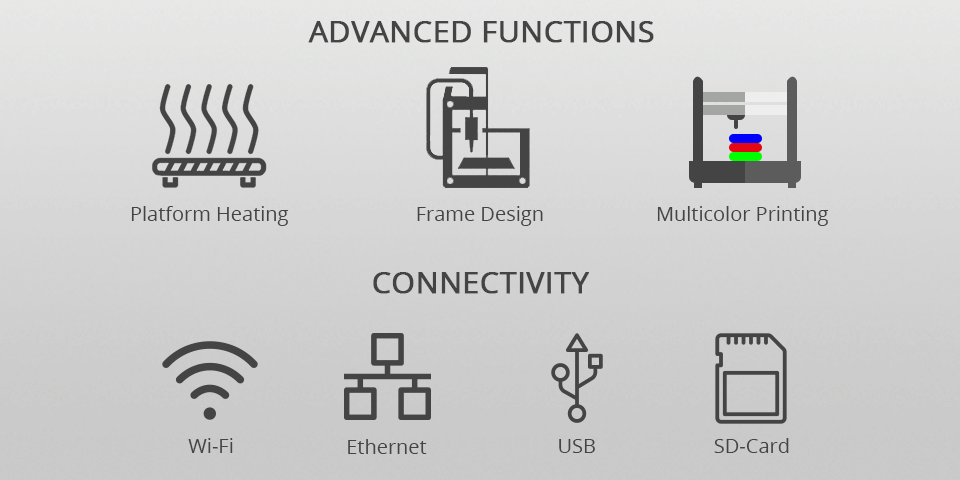
Platform heating. A good platform allows sticking the object during printing and easily removing it afterward. Glass platforms covered with masking tape or a glue layer are a particularly popular choice. Heating the platform can prevent difficulties and twisted lower edges, which is a common problem in an ABS 3D printer.
Frame construction. Closed 3D printers have a door, walls, and a lid, which can all serve as UV filters. Open models offer better monitoring and access, while a closed frame is safer, preventing accidental contact with the heated extruder, removing the fan noise and the smells of burning materials.
Multicolor printing. 3D-printers with two extruders can print objects in several colors. Be warned though that color printing is only possible if the object files are meant for multicolor printing (have a separate file for each color) as the differently-colored areas combine like pieces of a puzzle.
Connectivity. Most 3D-printers can be connected via USB, but some models also offer Ethernet or Wi-Fi connectivity. However, if the 3D-print file is larger than 10MB that can be a problem. SD-card slots allow uploading and printing 3D-object files without a PC. Some printers even have built-in memory and can continue printing even after the PC was disconnected.
FAQ
- • What is a 3D printer, and how does it work?
A 3D printer is a device that creates three-dimensional objects by adding successive layers of material on top of each other. It uses digital 3D models as a blueprint and translates them into physical objects through a process called additive manufacturing.
- • What materials can I use with a 3D printer?
3D printers can use a wide range of materials, including plastics (such as PLA, ABS, and PETG), resins, metals, ceramics, wood, and even food-based materials like chocolate or sugar.
- • How long does it take to 3D print an object?
The printing time depends on the complexity and size of the object, as well as the chosen print settings. Small and simple objects may take a few minutes, while larger and intricate designs can take several hours or even days.
- • Are 3D printed objects as strong as traditionally manufactured ones?
The strength of 3D printed objects depends on the material used and the printing technique. While some 3D printed parts can be strong and durable, others may have limitations in comparison to traditionally manufactured items.























